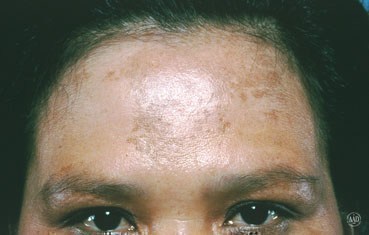Melasma

(c)American Academy of Dermatology
What is melasma?
Melasma (muh-LAZ-muh) is a common skin problem. It causes brown to gray-brown patches, usually on the face. Most people get it on their cheeks, bridge of their nose, forehead, chin, and above their upper lip. It also can appear on other parts of the body that get lots of sun, such as the forearms and neck.
One of the most common treatments for melasma is sun protection. This means wearing sunscreen every day and reapplying the sunscreen every 2 hours. Dermatologists also recommend wearing a wide-brimmed hat when you are outside. Sunscreen alone may not give you the protection you need.
Women are far more likely than men to get melasma. It is so common during pregnancy that melasma is sometimes called “the mask of pregnancy.” Hormones seem to trigger melasma.
How do dermatologists diagnose melasma?
Dermatologists can diagnose most patients by looking at their skin. To see how deeply the melasma penetrates the skin, your dermatologist may look at your skin under a device called a Wood’s light.
Sometimes melasma can look like another skin condition. To rule out another skin condition, your dermatologist may need to remove a small bit of skin. This procedure is called a skin biopsy. A dermatologist can safely and quickly perform a skin biopsy during an office visit.
How do dermatologists treat melasma?
Melasma can fade on its own. This usually happens when a trigger, such as a pregnancy or birth control pills, causes the melasma. When a woman delivers her baby or stops taking the birth control pills, melasma can fade.
Some people, however, have melasma for years — or even a lifetime. If the melasma does not go away or a woman wants to keep taking birth control pills, melasma treatments are available.
These include:
Hydroquinone: This medicine is a common first treatment for melasma. It is applied to the skin and works by lightening the skin. You will find hydroquinone in medicine that comes as a cream, lotion, gel, or liquid. You can get some of these without a prescription. These products contain less hydroquinone than a product that your dermatologist can prescribe.
Tretinoin and corticosteroids: To enhance skin lightening, your dermatologist may prescribe a second medicine. This medicine may be tretinoin or a corticosteroid. Sometimes a medicine contains 3 medicines (hydroquinone, tretinoin, and a corticosteroid) in 1 cream. This is often called a triple cream.
Other topical (applied to the skin) medicines: Your dermatologist may prescribe azelaic acid or kojic acid to help lighten melasma.
Procedures: If medicine you apply to your skin does not get rid of your melasma, a procedure may succeed. Procedures for melasma include a chemical peel, microdermabrasion, dermabrasion, laser treatment, or a light-based procedure. Only a dermatologist should perform these procedures.
New skin problems can occur when the person who gives the treatment does not tailor it to the patient’s skin type.


